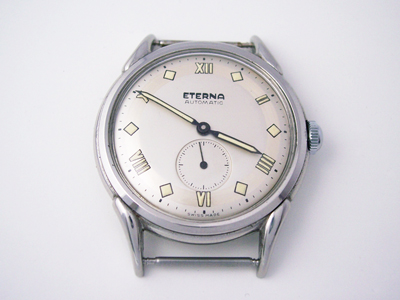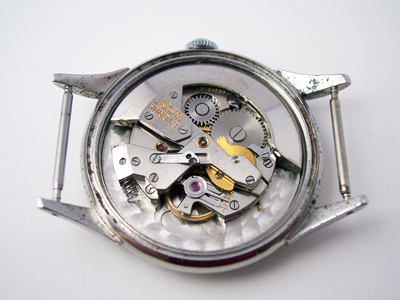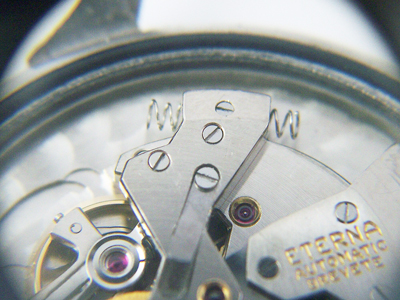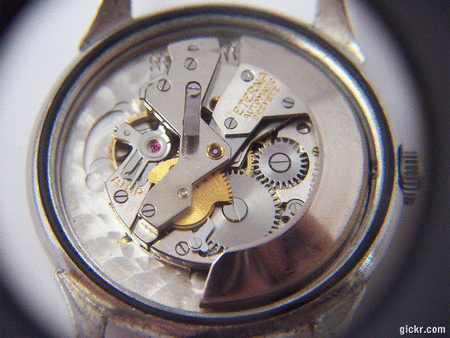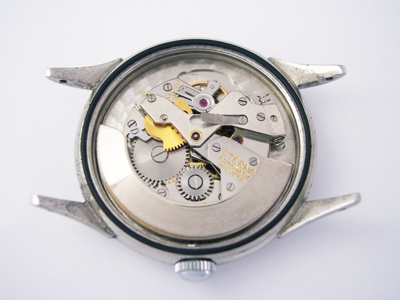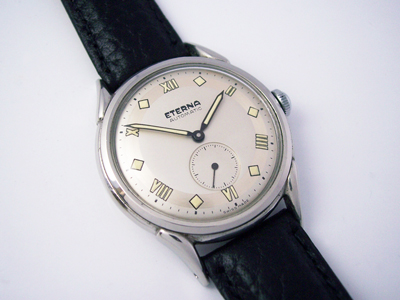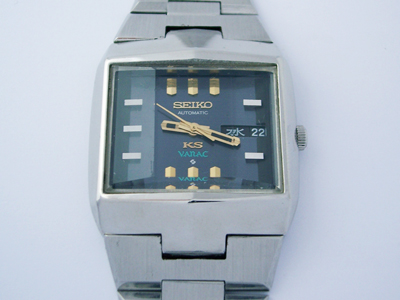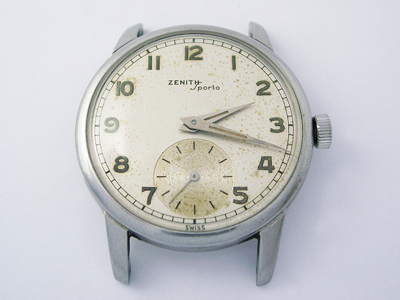Cutting quite a dash on the blog is this dress watch from Eterna.
(Click pictures to enlarge)
Time has certainly been kind to this watch as an inscription on the caseback dates it to 1947, making it a sprightly 65 years old. Removing the caseback and taking a look inside revealed an Eterna Cal. 1076H – a style of movement that I’ve yet to talk about on the blog, a ‘bumper automatic’.
Bumper automatics were the first self-winding wristwatches, and were initially developed by John Harwood, a watch repairer from Bolton, who patented his invention in 1923. Harwood’s system uses a pivoting weight which swings back and forth as the wearer moves, transferring power to the mainspring.
The motion of the winding rotor is restricted to an arc of around 300 degress, at which point the rotor bumps against one of two stops, each protected by a spring. This abrupt halt can be felt when wearing (or holding) the watch, hence the name ‘bumper automatic’.
Another feature of bumper automatics is that they only wind the mainspring in one rotor direction. In the return direction, the mechanism simply ‘freewheels’ back to the starting position.
Below is an image showing the two extremes of the winding action. At the heart of the mechanism is a ratchet and pawl. If you look at the (gold coloured) ratchet lever you will see that it moves back and forth with the movement of the rotor. It’s this action that transfers power to the mainspring barrel.
Although something of a breakthrough in its day, it was a relatively inefficient mechanism and the design was soon surpassed by ‘full rotor automatics’ in which the winding rotor is free to rotate 360 degrees left or right. Depending on the design, power can be transferred to the mainspring as the rotor rotates in either one or both directions. Rolex pioneered full rotor automatics, releasing their first Oyster Perpetual model in 1931 – the ‘Perpetual’ part of the model name denoting the perpetual movement of the winding rotor.
Ok, back to business. The watch arrived in running order but was loose inside the case. In the first movement picture you may have noticed an ugly piece of bent metal sticking up from the centre. As the winding rotor occupies almost all the space inside the case there is no room for a traditional ring/spacer to hold the movement in place. To overcome this problem, a casing spring is attached to the top of the movement and as the caseback is tightened, the spring is compressed, securing the movement inside the case.
The original spring had obviously been lost or broken during the last service, and the watchmaker attempted to make a replacement spring from any old piece of metal that was handy – it looks like part of an old train bridge to me. It didn’t work, and it was not the most aesthetically pleasing solution anyway, I’m sure you’ll agree.
To put things right I made a new casing spring from a thin piece of steel which I shaped to fit and then drilled at one end to secure it in place. With that problem solved, the movement was then given a full service to bring it back up to scratch.
The owner asked me if I thought the dial had been re-finished as its condition is near perfect – something you don’t often see in a watch of this age. Inspecting the dial and hands with a microscope it is clear to see that the hands and dial markers have been re-lumed at some point, but whether the dial has been re-finished too I couldn’t say for sure – given its condition it would be easy to assume that is has, but if so then it was extremely well done.
Re-finished dial or not, the watch is certainly attractive, and I’m sure it could find a place in anyone’s collection.
Rich.
** Many thanks to Neil Clarke for letting me feature his watch on the blog. **

